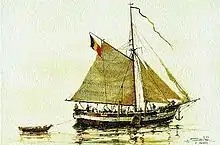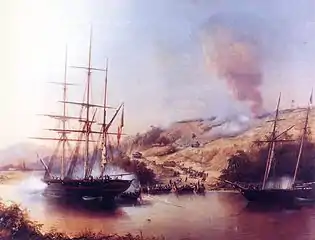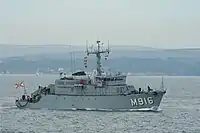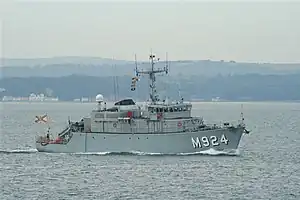| Naval Component | |
|---|---|
| |
| Founded | 1831 |
| Country | |
| Type | Navy |
| Role | Maritime warfare |
| Size | 1,300 |
| Part of | |
| Garrison/HQ | Zeebrugge, Bruges, Ostend |
| Ship classes | |
| Commanders | |
| Commander | Divisional admiral Tanguy Botman |
| Admiral Benelux | Vice admiral René Tas |
| Insignia | |
| Naval ensign |  |
| Naval jack |  |
The Belgian Navy, officially the Naval Component (Dutch: Marinecomponent, pronounced [maːˈriːnəkɔmpoːˌnɛnt]; French: Composante marine, pronounced [kɔ̃pozɑ̃t maʁin]; German: Marinekomponente, pronounced [maˈʁiːnəkɔmpoˌnɛntə]) of the Belgian Armed Forces,[1][2][3][4] is the naval service of Belgium.
History
Early history


The Belgian Navy was created as the Marine Royale (English: Royal Navy) in 1831.[5] This force has operated in various forms throughout Belgian history.
When the country became independent after the Belgian Revolution of 1830, a Dutch squadron blocked the Scheldt estuary. To deal with this threat the Belgian Congress ordered two brigantines to be built, which bore the names Congrès and Les Quatre Journées. After the French Army, led by Marshal Count Gérard, captured the citadel of Antwerp in 1832, the captured Dutch gun boats were pressed into Belgian service. In 1840 the Belgian government bought the schooner Louise Marie and in 1845 the brig Duc de Brabant. Louise Marie participated in the Rio Nuñez Incident in 1849. In 1862, the Belgian government discarded its navy and pursued a minimalistic naval policy.
Disbandment
In April 1862 the existing royal navy was disbanded as an economy measure. The navy's personnel were transferred to a "state navy force" manning small vessels and employed in non-military functions such as the provision of ferry services, inspection of incoming vessels and charting research. The need for a proper naval service to provide coastal and port defence was raised periodically but did not progress beyond the retention as a reserve of four lightly armed gunboats, moored in the Port of Antwerp and crewed by members of the Belgian Army's Engineering Corps.[6]
World War I
At the outbreak of World War I, Belgium had no navy (an impromptu force was assembled at the Battle for Lake Tanganyika) but the war caused this policy to change and a Corps of Destroyers and Sailors was created in 1917. The Belgian naval personnel served onboard French minesweepers and provided the artillerymen for Belgian merchant ships. The Treaty of Versailles allocated Belgium 11 torpedo boats and 26 minesweepers. For budgetary reasons, Belgium again abolished its navy in 1927.
World War II
In 1939, against the looming threat of a new war with Germany, Belgium once again resurrected its navy as the Naval Corps. This new navy, consisting mostly of small patrol vessels and coastal artillery units, lasted barely a year until the German invasion of May 1940. During the 18 days campaign, the trawler A4 evacuated much of the government's gold reserve to Britain, while several others helped at the Allied evacuation at Dunkirk.[7]
During World War II many members of the Naval Corps, together with Belgian fishermen and merchant sailors, escaped to Britain with the explicit wish of fighting the German occupiers. The Royal Navy took advantage of this opportunity to enlist the Belgians into separate groups of more or less entirely Belgian-crewed ships. From 1940 to 1946, the Belgian Section of the British Royal Navy crewed two corvettes, (Buttercup and Godetia), a squadron of MMS minesweepers and three patrol boats (Phrontis, Electra and Kernot). In 1946, Britain donated the ships to Belgium. These vessels became the backbone of the new Belgian Navy.
Cold War
Post-Cold War
In the beginning of the nineties, the end of the Cold War caused the Belgian government to restructure the Belgian Armed Forces in order to cope with the changed threats. This led to a reduction in the size of the Armed Forces. With regards to the Belgian navy, these cutbacks meant that one Wielingen-class frigate was taken out of service and that three Tripartite-class minehunters were sold to France. In 2002, the government decided to impose a "single structure" on the armed forces in which the independent Belgian Marine Royale ceased to exist. The former Navy became the Belgian Naval Component (COMOPSNAV) of the Armed Forces; it is also generally referred to as the Belgian Navy.
On 20 July 2005, the Belgian government decided to buy two of the remaining six Dutch M-class frigates to replace the two remaining frigates of the Wielingen class (Wielingen and Westdiep) currently still in service with the Belgian Navy, which in turn might be sold to Bulgaria. On 21 December 2005, the Dutch government sold Karel Doorman (F827) and Willem Van Der Zaan (F829) to Belgium. The two ships were sold for about 250 million Euros. These two M-class frigates entered service with the Belgian Navy where they were renamed Leopold I and Louise-Marie. In October 2005, the Wielingen-class frigate Wandelaar was officially handed over to the Bulgarian Navy, which christened the ship as Drăzki ('The Bolds'). The remaining ships of the class were transferred to Bulgaria as well, after completing modernization in Belgium. A Tripartite-class minehunter, Myosotis, which was renamed Tsibar was transferred to Bulgaria soon after.
The current Commander of the Naval Component is Rear Admiral Jan De Beurme (since September 2020).
In February 2013 it was announced that Belgium had ordered two 52-metre (171 ft) patrol vessels from the French shipyard SOCARENAM, to be delivered within two years. Both were received, P901 Castor in 2014 and P902 Pollux in early 2015. The two vessels are to remain in service until 2044–2045[8]
Mission
In times of crisis and war the Belgian Naval Component will manage, with the support of its allies, the crises rising from the infringements to the principles of International law and/or from the Humans right and exercise the Belgian sovereignty in the maritime zones where the Naval Component is qualified, defend the underwater communication lines, main roads and allied, and protect the ports against any air, surface or underwater attack.
In times of peace the Belgian Naval Component has the following roles:
- To ensure the presence of Belgium at sea.
- To give a support for our diplomacy and our foreign trade.
- Technical and military collaboration with the allied countries.
- Participation in humane actions.
- Contribute to the nation in the maritime zones for which Belgium is responsible:
- Contribution to oceanographic search.
- Control of fishing
- Contribution to the control of pollution at sea.
- Participation in the plan of assistance in territorial waters
- Support for the customs and police operations
- Detection of wrecks of boats.
- Participation in rescues at sea.
- Contribution to the training of the commercial naval officers
- Control of territorial waters and the exclusive economic zone.
- If necessary, opening of the centre of hyperbare medicine to the population.
- Destruction of explosive devices at sea
- Preparation with the tasks to be carried out in times of crisis and war.
- Contribution to dissuasion at sea by the means of permanent allied squadrons.
Organisation
Leadership
Ranks
Officer ranks
| NATO code | OF-10 | OF-9 | OF-8 | OF-7 | OF-6 | OF-5 | OF-4 | OF-3 | OF-2 | OF-1 | OF(D) | Student officer | ||||||||||||||||||||||||
|---|---|---|---|---|---|---|---|---|---|---|---|---|---|---|---|---|---|---|---|---|---|---|---|---|---|---|---|---|---|---|---|---|---|---|---|---|
 |
 |
 |
 |
 |
 |
 |
 |
 |
 |
 | ||||||||||||||||||||||||||
| Admiraal | Vice-admiraal | Divisieadmiraal | Flottieljeadmiraal | Kapitein-ter-zee | Fregatkapitein | Korvetkapitein | Luitenant-ter-zee 1ste klasse | Luitenant-ter-zee | Vaandrig-ter-zee | Vaandrig-ter-zee 2de klasse | ||||||||||||||||||||||||||
| Amiral | Vice-amiral | Amiral de division | Amiral de flottille | Capitaine de vaisseau | Capitaine de frégate | Capitaine de corvette | Lieutenant de vaisseau de 1re classe | Lieutenant de vaisseau | Enseigne de vaisseau | Enseigne de vaisseau de 2e classe | ||||||||||||||||||||||||||
| Admiral | Vizeadmiral | Divisionsadmiral | Flotillenadmiral | Kapitän zur See | Fregattenkapitän | Korvettenkapitän | Linienschiffsleutnant 1. klasse | Linienschiffsleutnant | Seefahnrich | Seefahnrich 2. klasse | ||||||||||||||||||||||||||
Other ranks
| NATO code | OR-9 | OR-8 | OR-7 | OR-6 | OR-5 | OR-4 | OR-3 | OR-2 | OR-1 | |||||||||||||||||||||||||||
|---|---|---|---|---|---|---|---|---|---|---|---|---|---|---|---|---|---|---|---|---|---|---|---|---|---|---|---|---|---|---|---|---|---|---|---|---|
 |
 |
 |
 |
 |
 |
 |
 |
 |
 |
 |
 | |||||||||||||||||||||||||
| Oppermeester-Chef | Oppermeester | Eerste meesterchef | Eerste meester | Meester-chef | Meester | Tweede meester | Eerste kwartiermeester-chef | Kwartiermeester-chef | Kwartiermeester | Eerste matroos | Matroos | |||||||||||||||||||||||||
| Maître principal-Chef | Maître-principal | Premier-maître chef | Premier maître | Maître-chef | Maître | Second-maître | 1er Quartier-maître-chef | Quartier-maître-chef | Quartier maître | Premier matelot | Matelot | |||||||||||||||||||||||||
| Chefhauptmeister | Hauptmeister | Erster Chefmeister | Erster Meister | Meister-Chef | Meister | Zweiter Meister | 1er Oberquartiermeister | Oberquartiermeister | Quartiermeister | 1er Matrose | Matrose | |||||||||||||||||||||||||
Current fleet list
Frigates
| Class | Ship | No. | Commissioned | Builder | Origin | Displacement (tonnes) |
Speed (knots) |
Photo |
|---|---|---|---|---|---|---|---|---|
| Karel Doorman class | Leopold I | F930 | 31 May 1991 (Netherlands) 29 March 2007 (Belgium) |
Schelde Naval Shipbuilding | 2,800 | 30 | .jpg.webp) | |
| Louise-Marie | F931 | 28 November 1991 (Netherlands) 8 April 2008 (Belgium) |
.jpg.webp) |
Minesweepers and minehunters
| Class | Ship | No. | Commissioned | Builder | Origin | Displacement (tonnes) |
Speed (knots) |
Photo |
|---|---|---|---|---|---|---|---|---|
| Tripartite class | Bellis | M916 | 13 August 1986 | Mercantile-Belyard Shipyard | 536 | 12 |  | |
| Crocus | M917 | 3 September 1986 |  | |||||
| Lobelia | M921 | 3 February 1988 | ||||||
| Narcis | M923 | 30 March 1990 |  | |||||
| Primula | M924 | 20 December 1990 |  |
Patrol boats
| Type | Ship | No. | Commissioned | Builder | Origin | Displacement (tonnes) |
Speed (knots) |
Photo |
|---|---|---|---|---|---|---|---|---|
| Castor class | Castor | P901 | 10 July 2014 | Sociéte Calaisienne de Réparation Navale et Mécanique (SOCARENAM) | 569 | 22 |  | |
| Pollux | P902 | 6 May 2015 |  |
Aircraft
Aircraft operated by 40th Squadron Heli, from the Belgium Air Component.
| aircraft | role | number in use | photo |
|---|---|---|---|
| NH90 | troop transport and search and rescue | 4 | .jpg.webp) |
Past fleet list
Belgian Navy ships since 1945:
- Tacoma-class frigate
- F910 Victor Billet, Tacoma-class frigate (decommissioned 1959, scrapped)
- Wielingen-class frigate
- F910 Wielingen, Wielingen-class frigate (decommissioned in the summer of 2007 and sold to Bulgaria)
- F911 Westdiep, Wielingen-class frigate (decommissioned on 5 October 2007 and sold to Bulgaria)
- F912 Wandelaar, Wielingen-class frigate (decommissioned and sold to Bulgaria in 2005)
- F913 Westhinder, Wielingen-class frigate (decommissioned 1993, scrapped)
- Tripartite-class minehunter
- M915 Aster, Tripartite minehunter
- M918 Dianthus, Tripartite minehunter (sold to France 1993)
- M919 Fuchsia, Tripartite minehunter (sold to France 1993)
- M920 Iris, Tripartite minehunter (sold to France 1993)
- M922 Myosotis, Tripartite minehunter (sold to Bulgaria 2007)
- Algerine-class minesweeper
- M900 Adrien de Gerlache (ex HMS Liberty, acquired 1949 – decommissioned 1969)
- M901 Georges Lecointe (i) (ex HMS Cadmus, acquired 1950 – decommissioned 1959)
- M901 Georges Lecointe (ii) (ex HMCS Wallaceburg, acquired 1959 – decommissioned 1969)
- M902 Van Haverbeke (i) (ex HMS Ready – acquired 1951 – decommissioned 1960)
- M903 Dufour (i) (ex HMS Fancy – acquired 1951 – decommissioned 1959)
- F903 Dufour (ii) (ex HMCS Winnipeg – acquired 1959 – decommissioned 1966)
- M904 De Brouwer (i) (ex HMS Spanker – acquired 1953 – decommissioned 1966)
- M905 De Moor (ex HMS Rosario – acquired 1953 – decommissioned 1966)

- MSO-class minesweeper (Aggressive class)
- M902 Van Haverbeke (ii) (ex USN MSO522 – acquired 1960 – decommissioned)
- M903 Dufour (ex USN AM498 – ex USN MSO522 – ex Norwegian Navy M951 Lagen – acquired 1966 – decommissioned 1985)
- M904 Debrouwer (ex USN AM499 – ex USN MSO499 – ex Norwegian Navy M952 Namsen – acquired 1966 – decommissioned 1993)
- M906 Breydel (ex USN AM504, ex USN MSO504, acquired 1956 – decommissioned 1993)
- M907 Artevelde (ex USN AM503, ex USN MSO503, acquired 1955 – decommissioned 1985)
- M908 Truffaut (ex USN AM515, ex USN MSO515, acquired 1956 – decommissioned 1993)
- M909 Bovesse (ex USN AM516, ex USN MSO516, acquired 1957 – decommissioned 1993)
- Pico (ex USN AM497 – ex USN MSO497 – ex Portuguese Navy M418 Pico – acquired 1974 for spares, subsequently stripped and abandoned, never commissioned)
- MSC-class coastal minesweeper (including 26 Adjutant-class minesweepers provided through US MDAP)
- M910 Diest (sold to Taiwan 1969)
- M911 Eeklo (sold to Taiwan 1969)
- M912 Lier (sold to Taiwan 1969)
- M913 Maaseik (sold to Taiwan 1969)
- M914 Roeselare (sold to Norway 1966)
- M915 Arlon (sold to Norway 1966)
- M916 Bastogne (sold to Norway 1966)
- M917 Charleroi (sold to Taiwan 1969)
- M918 Sint-Niklaas (sold to Taiwan 1969)
- M919 Sint-Truiden (sold to Greece 1969)
- M920 Diksmuide (sold to Taiwan 1969)
- M921 Herve (sold to Greece 1969)
- M922 Malmedy (sold to Greece 1969)
- M923 Blankenberge (sold to Greece 1969)
- M924 Laroche (sold to Greece 1969)
- M925 De Panne (retired from service 1969)
- M926 Mechelen (converted to research ship – decommissioned)
- M927 Spa (converted to munition transport and renumbered A963 – decommissioned and sold to a Dutch foundation, re-commissioned as museum ship AMS60 Bernisse)
- M928 Stavelot (decommissioned 1987)
- M929 Heist (decommissioned 1992)
- M930 Rochefort (decommissioned 1992)
- M931 Knokke (decommissioned 1976)
- M932 Nieuwpoort (decommissioned 1991)
- M933 Koksijde (decommissioned 1991)
- M934 Verviers (ex USN MSC259 – converted to minehunter 1972 – decommissioned 1988)
- M935 Veurne (ex USN MSC260 – converted to minehunter 1972 – decommissioned 1987)
- MSI-class inshore minesweepers (similar to the British Ham or Ley classes)
- M470 Temse (sold to South Korea 1970)
- M471 Hasselt (decommissioned 1989; transferred to Belgian Sea Cadet Corps in 1993)
- M472 Kortrijk (decommissioned 1989)
- M473 Lokeren (decommissioned 1987)
- M474 Turnhout (decommissioned 1991)
- M475 Tongeren (decommissioned 1991)
- M476 Merksem (decommissioned 1992)
- M477 Oudenaarde (decommissioned 1989; stored on dry land in Antwerp)
- M478 Herstal (decommissioned 1991)
- M479 Huy (decommissioned 1990)
- M480 Seraing (decommissioned 1990)
- M481 Tournai (sold to South Korea 1970)
- M482 Visé (decommissioned 1991)
- M483 Ougrée (decommissioned 1992; she is in civilian ownership on the River Medway in Chatham, Kent, England (2007))
- M484 Dinant (decommissioned 1992)
- M485 Andenne (decommissioned 1991)
- Motorminesweeper 105 class
- M940 (decommissioned 1954)
- M941 (decommissioned 1954)
- M942 (decommissioned 1954)
- M943 (decommissioned 1954)
- M944 (decommissioned 1954)
- M945 (decommissioned 1954)
- M946 (decommissioned 1954)
- M947 (decommissioned 1954)
- Miscellaneous combatant vessels
- Barcock (Bar-class boom defence vessel); ex-Royal Navy HMS Barcock; acquired 1946; returned 1949)
- Bootsman Jonson (minesweeper; ex-Kriegsmarine V1001; acquired 1944; decommissioned 1949)
- Bootsman Jonson 2 (minesweeper; ex-Kriegsmarine V1300; acquired 1948; decommissioned 1952)
- Patrol boats
- P900 Ijzer (decommissioned 1969; fate unknown)
- P901 Leie (decommissioned 1983; sold privately; acquired by Royal Belgian Sea Cadet Corps in later sale)
- P902 Dender (sold in 1954 without being commissioned)
- P902 Liberation (decommissioned 2011; donated to acquired by Royal Belgian Sea Cadet Corps in 2012)
- P903 Meuse (decommissioned 1983; on display at Royal Museum of the Armed Forces and Military History, Brussels)
- P904 Sambre (decommissioned 1983; donated to Royal Belgian Sea Cadet Corps 1985)
- P905 Schelde (decommissioned 1983; stored on dry land in Antwerp)
- P906 Semois (decommissioned 1983; sold privately 1985; sunk during storm in Alicante, Spain 1992)
- P907 Rupel (decommissioned 1983; sold privately 1985; awaiting overhaul by current owner)
- P908 Ourthe (decommissioned 1983; sold privately 1985; fate unknown)
- Auxiliary ships
- A950 Sub-Lieutenant Valcke (tug; built 1951; decommissioned 1980; sold privately)
- A951 Hommel (harbor tug; built in Germany 1953; decommissioned 1999)
- A952 Wesp (harbor tug; built in Germany 1953; decommissioned 1984)
- A952 Bij (harbour tug; built in The Netherlands 1959; decommissioned 1986)
- A955 Eupen (decommissioned 1966)
- A956 Krekel (harbour tug; built in Belgium 1961; decommissioned 1986)
- A957 Kamina (former German U-boat tender Herman von Wissmann; also wore pennant numbers AP907 and AP957; decommissioned 1967)
- A959 Mier (harbour tug; decommissioned 1984)
- A960 Godetia (MCM Logistics & Command ship, decommissioned 2021)
- A961 Zinnia (supply ship; decommissioned 1993; scrapped 2007)
- A962 Mechelen (ex-M926 Mechelen; converted to research ship 1963; decommissioned 1983)
- A962 Belgica (decommissioned 2021, gifted to Ukraine)
- A963 Spa (ex-M927 Spa; converted to munitions transport ship 1978; decommissioned and sold 1993)
- A963 Stern, (ex-Swedish coastguard ship, laid down 1979, in Belgian service 2000, decommissioned 2014) Ready Duty Ship
- A964 Heist (ex-M929 Heist; converted to auxiliary ship 1978; reconverted to M929 Heist 1985)
- A983 Quatuor (royal yacht; sold 2013)
- A996 Albatros (ready duty ship; decommissioned 2014)
- A999 Barbara, hovercraft (decommissioned 2009)
- Avila (royal yacht; on display at Royal Museum of the Armed Forces and Military History, Brussels)
- Inga 1 (tug; built 1959; abandoned in Belgian Congo 1960)
- MTL551 (motor transport launch; ex-US Navy MTL551; acquired 1947; sold 1953)
- Inland waterways barges
- A998 Ekster (munitions transport barge; acquired 1953; decommissioned 1979)
- FN1 (abandoned in Belgian Congo 1960)
- FN2 (abandoned in Belgian Congo 1960)
- FN3 (abandoned in Belgian Congo 1960)
- FN4 (decommissioned 1982)
- FN5 (decommissioned 1982)
- FN6 (decommissioned 1982)
Belgian naval aircraft since 1945
| Type | Origin | Variants | Period of service | Notes | Aircraft serial |
|---|---|---|---|---|---|
| Aerospatiale Alouette III | France | SA.316B Alouette III | 1971 - 2021 | Three helicopters | M |
| Sikorsky S-58 | United States | HSS-1 Seabat | 1962 - 1971 | Two helicopters | B |
Future projects
In 2012–2015 the two Belgian Armed Forces frigates were upgraded, followed by the two frigates of the Dutch Navy.
In 2013 the first NH-90 Helicopter was delivered and introduced into service replacing the Westland Sea King and Alouette III from 2014 onwards.
In the strategic defense vision report of the Belgian government, it was stated that by 2030 the Belgian Naval component will have invested in two new frigates and six new minehunters.[10]
The Belgian Armed Forces and Royal Netherlands Navy will replace their M-class frigates with the Future Surface Combatant.[11]
In March 2019 the Belgian Armed Forces and the Royal Netherlands Navy announced that they will replace their Tripartite-class minehunters with six new minehunters each to be built by a consortium led by France's Naval Group.[12]
In 2023 Belgium decided to get a third patrol ship to patrol the Belgian sector of the North Sea. [13]
See also
References
- ↑ "La Défense" (in French). Archived from the original on 1 April 2016. Retrieved 25 March 2016.
- ↑ "Defensie" (in Dutch). Archived from the original on 20 March 2016. Retrieved 25 March 2016.
- ↑ Pike, John. "Belgium - Navy / Composante Maritime / Marinecomponent". globalsecurity.org. Archived from the original on 5 December 2017. Retrieved 7 May 2018.
- ↑ "Allied Maritime Command - National Support Elements". Archived from the original on 1 December 2017. Retrieved 24 November 2017.
- ↑ "The Navy". Royal Museum of the Armed Forces and Military History. Retrieved 25 May 2020.
- ↑ Lierneux, Dr Pierre (2015). The Belgian Army in the Great War. pp. 502–503. ISBN 978-3-902526-75-5.
- ↑ "Dunkerque". KLM-MRA Séction Marine. Archived from the original on 2 October 2013. Retrieved 28 September 2013.
- ↑ "Un chantier naval français construit les nouveaux patrouilleurs de la Marine". 5 February 2013. www.mil.be. Archived from the original on 7 April 2013. Retrieved 7 February 2013.
- ↑ "Akkoord over het strategisch plan voor Defensie 2030" (in Dutch). 22 December 2015. Archived from the original on 18 August 2016. Retrieved 21 August 2016.
- ↑ Fiorenza, Nicholas (29 May 2018). "Belgium approves M-frigate replacement". www.janes.com. Archived from the original on 29 May 2018. Retrieved 29 May 2018.
- ↑ Frans consortium mag nieuwe Belgische mijnenjagers bouwen (in Dutch)
- ↑ Belgium will get a third patrol ship (in English)
Further reading
- Leconte, Louis (1945). La marine de guerre belge (1830–1940). Brussels: Renaissance du Livre. OCLC 18663047.
- Van Raemdonck, Jasper (2000). Het Belgisch Marinekorps, 1939-1940. Erpe: De Krijger. ISBN 9789072547873.
- Koninckx, Christian (2020). De Belgische Marine sedert 1946 : Een geschiedenis. Tielt: Lannoo. ISBN 9782390251491.
External links
- official website of the Naval Component (in Dutch) (in French)
- http://zm-fn.blogspot.com/, non-official blog of pictures of our old ships, in French.
.jpg.webp)
